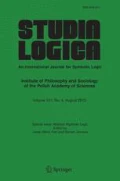Abstract
In this paper, bi-intuitionistic multilattice logic, which is a combination of multilattice logic and the bi-intuitionistic logic also known as Heyting–Brouwer logic, is introduced as a Gentzen-type sequent calculus. A Kripke semantics is developed for this logic, and the completeness theorem with respect to this semantics is proved via theorems for embedding this logic into bi-intuitionistic logic. The logic proposed is an extension of first-degree entailment logic and can be regarded as a bi-intuitionistic variant of the original classical multilattice logic determined by the algebraic structure of multilattices. Similar completeness and embedding results are also shown for another logic called bi-intuitionistic connexive multilattice logic, obtained by replacing the connectives of intuitionistic implication and co-implication with their connexive variants.
Similar content being viewed by others
References
Almukdad, A., and D. Nelson, Constructible falsity and inexact predicates, Journal of Symbolic Logic 49(1):231–233, 1984.
Anderson, A.R., and N.D. Belnap, Tautological entailments, Philosophical Studies 13:9–24, 1962.
Anderson, A.R., and N.D. Belnap, First degree entailments, Mathematische Annalen 149:302–319, 1963.
Anderson, A.R., and N.D. Belnap, Entailment: The Logic of Relevance and Necessity, vol. 1, Princeton University Press, Princeton, New Jersey, 1975.
Angell, R., A propositional logics with subjunctive conditionals, Journal of Symbolic Logic 27:327–343, 1962.
Arieli, O., and A. Avron, Reasoning with logical bilattices, Journal of Logic, Language and Information 5:25–63, 1996.
Belnap, N.D., A useful four-valued logic, in G. Epstein and J. M. Dunn (eds.), Modern Uses of Multiple-Valued Logic, Dordrecht, Reidel, 1977, pp. 5–37.
Belnap, N.D., How a computer should think, in G. Ryle (ed.), Contemporary Aspects of Philosophy, Oriel Press, Stocksfield, 1977, pp. 30–56.
Dunn, J.M., Intuitive semantics for first-degree entailment and ‘coupled trees’, Philosophical Studies 29(3):149–168, 1976.
Fitting, M., Bilattices are nice things, in T. Bolander, V. Hendricks, and S.A. Pedersen (eds.), Self-reference, CSLI Publications, Stanford, 2006, pp. 53–77.
Ginsberg, M., Multi-valued logics, Proceedings of AAAI-86, Fifth National Conference on Artificial Intelligence, Morgan Kaufman Publishers, Los Altos, 1986, pp. 243–247.
Ginsberg, M., Multivalued logics: a uniform approach to reasoning in AI, Computer Intelligence 4:256–316, 1988.
Goré, R., L. Postniece and A. Tiu, Cut-elimination and proof-search for bi-intuitionistic logic using nested sequents, in C. Areces and R. Goldblatt (eds.), Advances in Modal Logic, v. 7, College Publications, 2008, pp. 43–66.
Gurevich, Y., Intuitionistic logic with strong negation, Studia Logica 36:49–59, 1977.
Kamide, N., A hierarchy of weak double negations, Studia Logica 101(6):1277–1297, 2013.
Kamide, N., Trilattice logic: an embedding-based approach, Journal of Logic and Computation 25(3):581–611, 2015.
Kamide, N., and Y. Shramko, Embedding from multilattice logic into classical logic and vice versa, Journal of Logic and Computation 27(5):1549–1575, 2017, doi:10.1093/logcom/exw015.
Kamide, N., and H. Wansing, Symmetric and dual paraconsistent logics, Logic and Logical Philosophy 19(1-2):7–30, 2010.
Kamide, N., and H. Wansing, Proof theory of N4-related paraconsistent logics, Studies in Logic 54, College Publications, London, 2015.
Kamide, N., and H. Wansing, Completeness of connexive Heyting-Brouwer logic, IFCoLog Journal of Logic and their Applications 3:441–466, 2016.
Łukowski, P., Modal interpretation of Heyting-Brouwer logic, Bulletin of the Section of Logic 25(2):80–83, 1996.
Łukowski, P., A deductive-reductive form of logic: Intuitionistic S4 modalities, Logic and Logical Philosophy 10:79–91, 2002.
McCall, S., Connexive implication, Journal of Symbolic Logic 31:415–433.
Nelson, D., Constructible falsity, Journal of Symbolic Logic 14:16–26, 1949.
Odintsov, S.P., On axiomatizing Shramko-Wansing’s logic, Studia Logica, 93:407–428, 2009.
Odintsov, S.P., and H. Wansing, The logic of generalized truth-values and the logic of bilattices, Studia Logica 103:91–112, 2015.
Rauszer, C., A formalization of the propositional calculus of H-B logic, Studia Logica 33:23–34, 1974.
Rauszer, C., Applications of Kripke models to Heyting-Brouwer logic, Studia Logica 36:61–71, 1977.
Rauszer, C., An algebraic and Kripke-style approach to a certain extension of intuitionistic logic, Dissertations Mathematicae, Polish Scientific Publishers, Warsaw, 1980, pp. 1–67.
Rautenberg, W., Klassische und nicht-klassische Aussagenlogik, Vieweg, Braunschweig, 1979.
Shramko, Y., Truth, falsehood, information and beyond: the American plan generalized, in K. Bimbó (ed.), J. Michael Dunn on Information Based Logics, Springer, Dordrecht, 2016, pp. 191–212.
Shramko, Y., J.M. Dunn and T. Takenaka, The trilaticce of constructive truth-values, Journal of Logic and Computation 11:761–788, 2001.
Shramko, Y., and H. Wansing, Some useful sixteen-valued logics: How a computer network should think, Journal of Philosophical Logic 34:121–153, 2005.
Shramko, Y., and H. Wansing, Truth and Falsehood. An Inquiry into Generalized Logical Values, Springer, Dordrecht, 2011.
Takeuti, G., Proof theory, North-Holland Publishing Company, Amsterdam, 1975.
Vorob’ev, N.N., A constructive propositional calculus with strong negation (in Russian), Doklady Akademii Nauk SSSR 85:465–468, 1952.
Wansing, H., Connexive modal logic, Advances in Modal Logic vol. 5, College Publications, London, 2005, pp. 367–385.
Wansing, H., Constructive negation, implication, and co-implication, Journal of Applied Non-Classical Logics 18(2-3):341–364, 2008.
Wansing, H., Falsification, natural deduction and bi-intuitionistic logic, Journal of Logic and Computation 26(1):425–450, First published online, July 17, 2013.
Wansing, H., Connexive logic, The Stanford Encyclopedia of Philosophy (Fall 2014 Edition), E.N. Zalta (ed.), URL = http://plato.stanford.edu/archives/fall2014/entries/logic-connexive/ (First published January 6, 2006).
Wansing, H., On split negation, strong negation, information, falsification, and verification, in K. Bimbó (ed.), J. Michael Dunn on Information Based Logics, Springer, Dordrecht, 2016, pp. 161–189.
Wansing, H., Natural deduction for bi-connexive logic and a two-sorted typed \(\lambda \)-calculus, IFCoLog Journal of Logics and their Applications 3:413–439, 2016.
Wolter, F., On logics with coimplication, Journal of Philosophical Logic 27:353–387, 1998.
Author information
Authors and Affiliations
Corresponding author
Rights and permissions
About this article
Cite this article
Kamide, N., Shramko, Y. & Wansing, H. Kripke Completeness of Bi-intuitionistic Multilattice Logic and its Connexive Variant. Stud Logica 105, 1193–1219 (2017). https://doi.org/10.1007/s11225-017-9752-x
Published:
Issue Date:
DOI: https://doi.org/10.1007/s11225-017-9752-x




